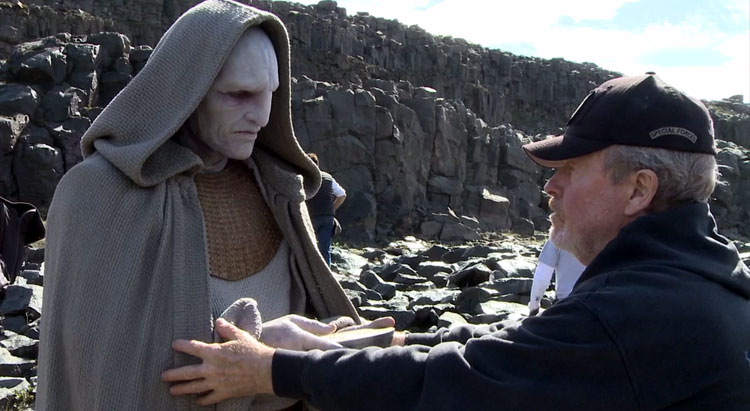
|

|

|

|

|

|

|

|

|

|

|

|


Who Did What?
Stammers gave most of the visual effects shots to MPC, Weta Digital, and Fuel, with Hammerhead, Rising Sun Pictures, Lola, Luma Pictures, Prologue, and two one-man teams from Pixel Pirates and Invisible Effects working in-house on comps and cleanups.
MPC, led by visual effects supervisor Charley Henley, was the lead vendor with around 450 shots. "Ridley felt they could do great environment work, as they had done for his Robin Hood and Kingdom of Heaven," Stammers says. "They did everything on the planet surface that the crew of Prometheus visits. So, rather than sharing work, we had them create the human and alien space ships, and therefore they also did the space travel shots and shots of the planet's atmosphere with cloud formations and electrical storms. Any time you see exterior planetary landscapes, that's all MPC's environment work. They also created the epic crash sequence and the alien ship rolling toward Vickers and Shaw, as well as some small creature sequences and prosthetic enhancements when the crew get infected in the film."
Weta Digital handled the majority of the creature work, though, creating around 250 shots, supervised on set by Everett Burrell and at Weta by Martin Hill. "They created the hero alien known as the Engineer," Stammers says. "That was a digital representation of the actor they had on set, suited in fantastic prosthetics."

Weta also created an opening sequence in which an Engineer sacrifices himself. "We see inside his body, his DNA being pulled apart," Stammers says. "It's a beautiful moment. They also created some disgusting, gory moments that will be well remembered for years to come. There's an automated surgery that's realized with CG robotic arms, and a great combination of prosthetic and CG body parts Ц it's really gross."
Fuel VFX had the next-largest number of shots, supervised by Paul Butterworth. "They created fantastically original designs for the aliens' holographic effects Ч pixilated, ghost-like holograms of fleeing figures that play beautifully in 3D," Stammers says. "Ridley wanted the holograms to look decayed, like they were thousands of years old."
Hammerhead also created a holographic representation at the beginning of the film to present a message from Peter Weyland, but one of their trickiest sequences was helping one of the characters lose his head. "For the most part, that's an elaborate split screen using a prosthetic head, but they had to do body removal and track in [the actor's] face onto the prosthetic head in stereo," Stammers says. "They did a great job of seamlessly blending it."
Rising Sun dramatically augmented close ups of a partially practical sandstorm that had been established in wide, full CG shots created by MPC, and picked up several monitor comps. Lola augmented the faces of the Engineer characters. "Ridley wanted to shoot as much practically as possible," Stammers says. "So we bulked out the 7-foot-1 actor's head and body with the prosthetics and makeup to sell him as an 8-foot giant. The slight drawback was that in bulking out his face, his features became disproportionately smaller. So, Lola rebalanced his features to make him look more godlike, more perfect."
In addition, Luma Pictures created a floating holographic screen, and Prologue put a welcome message into a holographic cube, created a dream sequence, and made the opening titles.
"We definitely had our challenges," Stammers says of the film. "And the pressure involved... If I had stopped to think that I was working on one of the most highly anticipated sci-fi films in a long time, I would have gone crazy. But everyone jumped to the challenge and did a fantastic job."
As for working with Ridley Scott? "I learned a huge amount, but if I had to put my finger on one thing, it's that nothing is set in stone. The thing you think is most precious could go at any point. You have to be prepared to lose your favorite shot for the greatest good."
